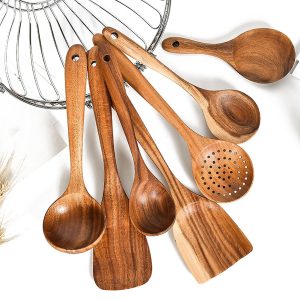The Ultimate Guide to Choosing the Perfect Wooden Spatula – Wooden spatulas are indispensable tools in any kitchen, offering versatility, durability, and a natural touch to your culinary adventures. Choosing the right one can significantly enhance your cooking experience -Wooden Spatula.
From flipping pancakes to stirring sauces, a well-selected wooden spatula can make all the difference. Here’s your comprehensive guide to finding the perfect wooden spatula:
The Ultimate Guide to Choosing the Perfect Wooden Spatula
1. Material Matters
Wooden spatulas are typically made from various types of wood. Look for hardwood options like maple, beech, or bamboo. These woods offer durability and are less likely to splinter or warp with extended use.
2. Handle Length and Grip
Consider the length of the handle. A longer handle provides better reach, especially for larger pans or deeper pots. Ensure the handle offers a comfortable grip that feels ergonomic in your hand.
3. Thickness and Sturdiness
The thickness of the spatula matters when it comes to sturdiness. It should be thick enough to handle heavier foods without bending but not too thick that it becomes unwieldy.
4. Head Shape and Size
The head of the spatula should be broad enough to handle different cooking tasks—flipping, scraping, stirring—yet not too wide for precision work. A slightly curved or flat head is ideal for versatile use.
5. Finish and Coating
Opt for spatulas with a smooth finish and no rough edges. Some spatulas might have a protective coating or finish. Ensure it’s food-safe and doesn’t chip off over time.
A Kitchen Essential The Versatile Ladle Spoon .
6. Heat Resistance
Wood is a natural insulator but can be sensitive to extreme heat. Look for heat-resistant wooden spatulas or those treated to withstand high temperatures without warping or cracking.
7. Maintenance and Care
Wooden spatulas require proper care to maintain their longevity. Consider whether the spatula is easy to clean and if it requires special care, such as handwashing or occasional oiling to prevent drying out.

8. Versatility
A great spatula can perform various tasks. Look for versatility in design that allows you to flip delicate foods like eggs as well as handle heartier ingredients without causing damage.
9. Brand and Quality
Reputable brands often prioritize quality materials and craftsmanship. Read reviews or seek recommendations to find a trusted brand that ensures reliability and durability.
10. Budget Consideration
Wooden spatulas come in various price ranges. Quality often corresponds with price, but you can find a balance between affordability and functionality by considering your specific cooking needs.
Conclusion
Finding the perfect wooden spatula involves considering a combination of factors, including material, design, functionality, and maintenance. Ultimately, the ideal spatula is one that feels comfortable in your hand and meets your cooking requirements.
Investing in a high-quality wooden spatula elevates your culinary experience, offering not just a tool but an extension of your cooking style. Take your time, explore options, and select the spatula that feels right for you and your kitchen.
How to Clean a Wooden Spatula: A Step-by-Step Guide
Wooden spatulas are fantastic kitchen tools. They require proper care to ensure longevity and hygiene. Cleaning them is simple when you follow these steps.
Materials You’ll Need:
Mild dish soap
Soft sponge or cloth
Warm water
Towel or dishcloth
Food-grade mineral oil (optional)
Step 1: Immediate Post-Use Rinse
After using your wooden spatula, rinse it under warm water to remove any food particles. Avoid using hot water, as extreme temperatures can potentially damage the wood by causing it to expand or contract.
Step 2: Washing with Mild Soap
Add a small amount of mild dish soap to the soft sponge or cloth. Gently scrub the entire spatula, paying attention to any stubborn residue. Ensure you clean both the front and back of the spatula.
Step 3: Rinse Thoroughly
Thoroughly rinse the spatula under warm running water, ensuring all soap residue is removed. Take care not to soak the spatula for an extended period as excessive water exposure can cause the wood to swell.
Step 4: Towel Dry
Using a clean towel or dishcloth, pat the wooden spatula dry. Remove as much moisture as possible to prevent water from seeping into the wood, which can lead to warping or cracking.
Step 5: Air Dry Completely
Allow the spatula to air dry completely in a well-ventilated area before storing it. Ensure it’s completely dry to prevent any potential growth of mold or mildew.
Step 6: Optional Oil Treatment
Periodically, you can apply a food-grade mineral oil to the wooden spatula to maintain its moisture and prevent it from drying out. Use a small amount of oil, rub it onto the spatula with a cloth, and let it absorb for a few hours or overnight. Wipe off any excess oil before using the spatula.
Additional Tips:
Avoid Dishwashers: Wooden spatulas are not dishwasher-safe. The prolonged exposure to water and heat in dishwashers can damage the wood.
Avoid Soaking: Never soak wooden spatulas for an extended period, as it can cause the wood to swell or crack.
Regular Maintenance: Consider giving your wooden spatula an occasional oil treatment to maintain its natural beauty and prevent it from drying out.
Cleaning a wooden spatula is a straightforward process involving gentle washing, thorough drying, and occasional oil treatment to maintain its quality. Avoiding harsh cleaning methods ensures your wooden spatula remains a reliable kitchen companion for years.